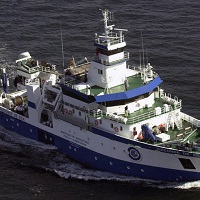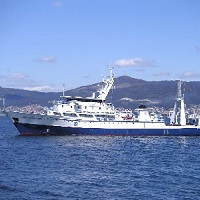Keyword
149
33 record(s)
Type of resources
Categories
Topics
INSPIRE themes
Keywords
Contact for the resource
Provided by
Years
Formats
Status
-

Estimar la abundancia de las poblaciones de peces demersales Analizar la estructura y diversos parametros biologicos de las especies mas importantes.
-

Abundance indices, distribution patterns and faunal assemblages of demersal species in the Flemish Cap bank, together with the possible driving factors of their distribution. This survey belongs to the research project: 'Biología Pesquera pesquerías Lejanas'. This Project is partly funded by the DCR of the EU and the Education and Science Spanish Ministery. The main objectives of the above mentioned project related with this survey time series are: a) to obtain abundance indices of the main exploited species in the Flemish Cap bank; b) to estimate the strength of yearly recruitments of these species and their distribution in the bank. c) to study the structure and distribution o the demersal and benthic communities in the area.
-

Abundance indices, distribution patterns and faunal assemblages of demersal species in the Flemish Cap bank, together with the possible driving factors of their distribution. This survey belongs to the research project: 'Biología Pesquera pesquerías Lejanas'. This Project is partly funded by the DCR of the EU and the Education and Science Spanish Ministery. T The main objectives of the above mentioned project related with this survey time series are: a) to obtain abundance indices of the main exploited species in the Flemish Cap bank b) to estimate the strength of yearly recruitments of these species and their distribution in the bank. c) to study the structure and distribution o the demersal and benthic communities in the area
-

The surveys on NAFO Regulatory Area of Div. 3L (Flemish Pass) were initiated by Spain in 2003. The surveys were carried out by the R/V ¿Vizconde de Eza¿ following the same procedures and using the same bottom trawl net type Campelen. The main objectives of this survey time series are: a) to obtain abundance indices of the main exploited species, b) to study the structure and distribution of these demersal species in the area.
-

This survey covers the international NAFO Regulation Area in divisions 3NO. It started in 1995 with the only purpose of collecting data for stock assessment of target species down to 700 m, but its aims and research area have widened with time. Currrently, the survey covers a depth range of 50-1500 m and its goals are the following: 1.Regarding the target species (Hippoglossoides platessoides, Limanda ferruginea, Reinhardtius hippoglossoides, Glyptocephalus cynoglossus, Gadus morhua, Sebastes sp, Macrourus berglax, Centroscyllium fabricii and Raja radiata) and other species of commercial interest (Urophycis tenuis; Pandalus borealis) : a) to obtain biomass and abundance indexes b) to estimate recruitment, c) to investigate the population structure To achieve this, biological information (length, weight, sex, maturity, stomach contents) is obtained from about 30 species, as well as otoliths and gonads from cod, Greenland halibut and roughead grenadier. The remaining fish and commercial invertebrate species are length measured and weighted. 2..Collection of oceanographic data (temperature, salinity, oxygen and fluorescence); 3.Invertebrate data collection: all species are identified to the maximum possible level on board, or otherwise photographed and preserved for later examination at the lab, counted and weighted, with the aim of investigating the benthic invertebrate faunal assemblage and presence of vulnerable species.
-
This was the fourth and last cruise undertaken as part of the NERC-funded consortium project (NE/C512961/1) entitled ECOMAR - Ecosystem of the Mid-Atlantic Ridge at the Sub-Polar Front and Charlie Gibbs Fracture Zone. http://www.oceanlab.abdn.ac.uk/ecomar/index.php ECOMAR forms part of the Census of Marine Life MAR-ECO project which is an international study of life in the northern mid-Atlantic Ocean with scientists from 16 nations participating in research of the waters around the mid-Atlantic Ridge from Iceland to the Azores (http://www.mar-eco.no). Depart: Wednesday, 26 May, St Johns, Newfoundland, Canada. Long term moorings were recovered at four super stations at a bottom depth of 2500m equipped with sediment traps, current meters, ADCP and sensor suites, SE - 49°01.92'N, 27°40.82'W, SW - 48°46.80'N, 28°38.43'W, NW - 53°59.33'N, 36°07.39'W and NE 54°00.05'N 34°10.58'W. Video and still images of the sea floor were obtained during 4 lander deployments and 21 ISIS ROV dives. Faunas samples were taken on 17 of these ROV dives, further samples from 13 successful megacorer casts and 4 baited traps. High definition video sea floor surveys were completed of approximately 50,000 m2 of sea floor. Arrive: Vigo, Spain, Saturday 3 July 2010.
-

Abundance indices, distribution patterns and faunal assemblages of demersal species in the Flemish Cap bank, together with the possible driving factors of their distribution. This survey belongs to the research project: ¿Biología Pesquera pesquerías Lejanas¿. This Project is partly funded by the DCR of the EU and the Education and Science Spanish Ministery. T The main objectives of the above mentioned project related with this survey time series are: a) to obtain abundance indices of the main exploited species in the Flemish Cap bank b) to estimate the strength of yearly recruitments of these species and their distribution in the bank. c) to study the structure and distribution o the demersal and benthic communities in the area
-
Campaña: 3LNO GROUNDFISH SURVEY (FLETAN NEGRO 3L 2012) 3LNO GROUNDFISH SURVEY (FLETAN NEGRO 3L 2012)

The surveys on NAFO Regulatory Area of Div. 3L (Flemish Pass) were initiated by Spain in 2003. The surveys were carried out by the R/V 'Vizconde de Eza' following the same procedures and using the same bottom trawl net type Campelen. The main objectives of this survey time series are: a) to obtain abundance indices of the main exploited species, b) to study the structure and distribution of these demersal species in the area.
-

Annually, the European Union develops two research campaigns in the area of NAFO (North Atlantic Fisheries Organization), one in the 3NO division and another in the 3M and 3L (Flemish Cap Series). This campaign is part of a historical series in order to provide indices for the evaluation of the stock of halibut and other groundfish species in the area such as flounder, redfish, grenadier, cod or shrimp. The Flemish Cap bank is an isolated bank of the American coastal platform with an area greater than 10,000 square miles and is located outside of the Exclusive Economic Zone of Canada. The exploitation of the resources of this area is regulated by the international agreements of NAFO. GOALS Estimation of abundance and biomass indices of the target species, as well as the study and analysis of the demographic structure of their populations and the oceanographic conditions in the Bank.
-

Annually, the European Union develops two research campaigns in the area of ¿¿NAFO (North Atlantic Fisheries Organization), one in the 3NO division and another in the 3M and 3L (Flemish Cap Series). This campaign is part of a historical series in order to provide indices for the evaluation of the stock of halibut and other groundfish species in the area such as flounder, redfish, grenadier, cod or shrimp. The Flemish Cap bank is an isolated bank of the American coastal platform with an area greater than 10,000 square miles and is located outside of the Exclusive Economic Zone of Canada. The exploitation of the resources of this area is regulated by the international agreements of NAFO. GOALS Estimation of abundance and biomass indices of the target species, as well as the study and analysis of the demographic structure of their populations and the oceanographic conditions in the Bank.
 Catálogo de datos del IEO
Catálogo de datos del IEO